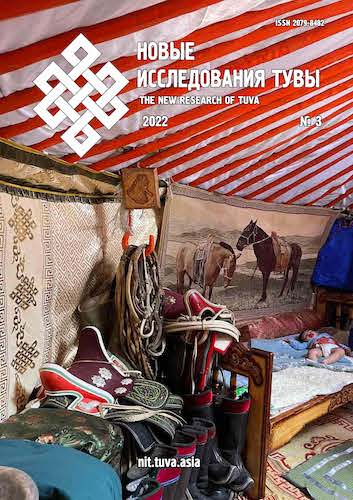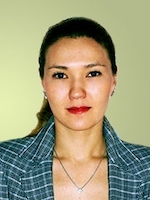Employment and income of the populations of the republics of Tuva and Bashkortostan (2010–2020)
DOI:
https://doi.org/10.25178/nit.2022.3.13Keywords:
standard of living; life quality; income; employment; social well-being; human potential; Republic of Tuva; Republic of Bashkortostan; Tuvans; BashkirsAbstract
The article examines employment and income issues of the populations in the Republic of Tuva and the Republic of Bashkortostan, including those relating to the position of the main ethnic groups. The analysis is performed in the context of the concept of human development and the possibility approach. Authors provide insight into the general and special features of employment, income and social well-being of the populations in the republics of Tuva and Bashkortostan for 2010–2020, including those in the context of ethnic groups. Combinations of objective data and subjective estimates of the population that characterize the spheres of employment and income are consistently analyzed. The empirical base of the research is consisted of official statistics (Rosstat) and the results of special sociological studies conducted in Tuva and Bashkortostan in 2021.
The ethnic factor in the republics consists in the level and types of economic activity of the population. The titular ethnic groups are more represented in the budget-funded sectors of the economy, the spheres of art and culture constitute a special “ethnic niche”. Ethnic differences in the republics are an objective consequence of sociocultural and resettlement factors rather than of discriminatory ones. The ethnic features of employment reveal themselves better in Tuva than in Bashkortostan, probably due to the greater representation of the titular ethnic group and a smaller quantity of intercultural interactions in the structure of the region’s population.
In both republics, there is an increasing instability of the labor market, a relatively high level of informal employment, a reduction in real incomes of the people and incomes from entrepreneurial activity. The life quality of the population in Tuva is significantly lower than that of the people in Bashkortostan and Russia as a whole due to the underdeveloped structure of the economy and low economic activity of the population. Bashkortostan is also characterized by processes that hinder human development.
References
Abylkalikov, S. I. and Baimurzina, G. R. (2022) Osobennosti demograficheskikh protsessov v gorodakh Kyzyl i Elista v 2011–2020 gody: sravnitel’nyi analiz [Demographic processes in the towns of Kyzyl and Elista in 2011–2020: A comparative study]. New Research of Tuva, no. 2, pp. 34–52. (In Russ.). DOI: https://doi.org/10.25178/nit.2022.2.3
Anaiban, Z. V. (2018) Trudovaia zaniatost' i sotsial'no-professional'nye orientatsii molodezhi sovremennoi Tuvy [Employment and socio-professional orientations of contemporary Tuva’s youth]. New Research of Tuva, no. 2, pp. 112–131. (In Russ.). DOI: https://doi.org/10.25178/nit.2018.2.6
Anaiban, Z. V. (2020a) Dinamika izmeneniia material'nogo polozheniia zhitelei sovremennoi Tuvy [Dynamics of changes in the financial situation of residents of contemporary Tuva]. Natsional'naia assotsiatsiia uchenykh, no. 54–2 (54), pp. 11–15. (In Russ.). DOI: https://doi.org/10.31618/nas.2413-5291.2020.2.54.198
Anaiban, Z. V. (2020b) Dinamika razvitiia etnodemograficheskikh protsessov v postsovetskoi Tuve [The dynamics of ethno-demographic processes development in post-Soviet Tuva]. Vestnik Instituta vostokovedeniia RAN, no. 2, pp. 284–293. (In Russ.). DOI: https://doi.org/10.31696/2618-7302-2020-2-284-293
Akhmetova, G. F. (2022) Migratsionnye protsessy v natsional’nykh respublikakh s raznym urovnem razvitiia chelovecheskogo potentsiala (na primere Bashkortostana, Tatarstana i Tuvy) [Migration processes in national republics with different levels of human development: The cases of Bashkortostan, Tatarstan and Tuva]. New Research of Tuva, no. 2, pp. 53–69. (In Russ.). DOI: https://doi.org/10.25178/nit.2022.2.4
Badmaeva, N. V. and Natsak, O. D. (2021) Sovremennaia trudovaia migratsiia iz Kalmykii i Tuvy: ekonomicheskie, sotsiokul’turnye i gendernye aspekty [Modern labor migration from Kalmykia and Tuva: Economic, socio-cultural and gender aspects]. New Research of Tuva, no. 4, pp. 186–205 (In Russ.). DOI: https://doi.org/10.25178/nit.2021.4.14
Balakina, G. F. (2022) Riski razvitiia chelovecheskogo potentsiala etnicheskikh obshchnostei Respubliki Tyva (1999–2021 gg.) [Risks in human development in ethnic communities of the Republic of Tuva (1999–2021)]. New Research of Tuva, no. 2, pp. 20–33. (In Russ.). DOI: https://doi.org/10.25178/nit.2022.2.2
Balakina, G. F. and Kylgydai, A. Ch. (2015) Issledovanie osobennostei rynka truda slabourbanizirovannogo regiona [Investigating the labor market specifics in the region with low rate of urbanization]. Ekonomicheskii analiz: teoriia i praktika, no. 35 (434), pp. 22–32. (In Russ.).
Bobkov, V. N., Guliugina, A. A., Kolmakov, I. B., Odintsova, E. V. and Chernykh, E. A. (2021) Monitoring dokhodov i urovnia zhizni naseleniia Rossii — 2020 god [Monitoring of incomes and living standards of the Russian population — 2020]. Moscow, Fabrika ofsetnoi pechati. 116 p. (In Russ.). DOI: https://doi.org/10.19181/monogr.978-5-89697-361-4.2021
Bulatova, A. I. (2020) Rol' i znachenie finansovoi gramotnosti naseleniia dlia effektivnogo razvitiia ekonomiki Rossii na primere Respubliki Bashkortostan [The role and significance of financial literacy of the population for effective development of the Russian economy on the example of the Republic of Bashkortostan]. Research result. Economic Research, vol. 6, no. 4, pp. 98–109. (In Russ.). DOI: https://doi.org/10.18413/2409-1634-2020-6-4-0-11
Valiakhmetov, R. M., Baimurzina, G. R., Turakayev, M. S. and Samba, A. D.-B. (2021) Etnosotsial’nye osobennosti zaniatosti naseleniia v respublikakh Tuva i Bashkortostan [Ethnic and social features of employment in the republics of Tuva and Bashkortostan]. New Research of Tuva, no. 4, pp. 206–222. (In Russ.). DOI: https://doi.org/10.25178/nit.2021.4.15
Valiakhmetov, R. M. (2015) Problemy razvitiia chelovecheskogo potentsiala Respubliki Bashkortostan [Human development issues in the Republic of Bashkortostan]. Sotsiologicheskie issledovaniia, no. 8 (376), pp. 50–55. (In Russ.).
Valiakhmetov, R. M., Baimurzina, G. R. and Utiasheva, I. B. (2018) Vozmozhnosti i perspektivy sotsiologicheskogo izmereniia chelovecheskogo potentsiala (na primere Respubliki Bashkortostan) [Opportunities and prospects of sociological measurement of human potential (by the example of the Republic of Bashkortostan)]. In: Rossiia reformiruiushchaiasia [Russia reforming] : Yearbook. Issue 16 / ed. by M. K. Gorshkov. Moscow, Novyi khronograf. 472 p. Pp. 216–237. (In Russ.). DOI: https://doi.org/10.19181/ezheg.2018.10
Vishnevskii, A. G. (2019) Demografiia v natsional'nykh proektakh: kak opredelit' prioritety? [Demography in national projects: How to determine priorities?]. Scientific Works of the Free Economic Society of Russia, vol. 217, no. 3, pp. 100–119. (In Russ.).
Gaifullin, A. Yu. (2022) Etnodemograficheskie kharakteristiki molodezhi v respublikakh Tyva i Bashkortostan [Ethnodemographics of youth in the republics of Tuva and Bashkortostan]. New Research of Tuva, no. 2, pp. 128–142. (In Russ.). DOI: https://doi.org/10.25178/nit.2022.2.9
Eremenko, S. L. (2014) Vliianie etnicheskoi identichnosti na ekonomicheskoe povedenie rossiian [Influence of ethnic identity on economic behavior of the Russians]. Obshchestvo i pravo, no. 1 (47), pp. 291–295. (In Russ.).
Zherebin, V. M. and Romanov, A. N. (2002) Uroven' zhizni naseleniia: osnovnye kategorii, kharakteristiki i metody otsenki [The standard of living of the population: The main categories, characteristics and methods of assessment]. Moscow, UNITY-DANA. 592 p. (In Russ.).
Zaslavskaia, T. I. (2005) Chelovecheskii potentsial v sovremennom transformatsionnom protsesse [Human potential in the modern transformation process]. Obshchestvennye nauki i sovremennost', no. 3, pp. 5–16. (In Russ.).
Zubarevich, N. V. (2014) Regional'noe razvitie i regional'naia politika v Rossii [Regional development and regional policy in Russia]. EKO, no. 4 (478), pp. 6–27. (In Russ.).
Ivanov, O. I. (2018) Strategiia transformatsii sotsial'nogo prostranstva razvitiia chelovecheskogo kapitala [Strategy of transformation of social space of human capital development]. Journal of Economy and Business, no. 12–1, pp. 146–150. DOI: https://doi.org/10.24411/2411-0450-2018-10237
Irnazarov, R. I. (2016) Etnichnost' v trudovoi zaniatosti naseleniia Respubliki Bashkortostan [Ethnicity in the employment of the population of the Republic of Bashkortostan]. In: Iz proshlogo v budushchee: sotsial'noe razvitie Respubliki Bashkortostan i Rossii [From the past to the future: Social development of the Republic of Bashkortostan and Russia] : A collection of research articles / ed. by F. B. Burkhanova. Ufa, Editorial and Publishing Center at Bashkir State University. 188 p. Pp. 26–37. (In Russ.).
Kabashova, E. V. and Rafikova, N. T. (2008) Statisticheskoe issledovanie dokhodov naseleniia i ikh differentsiatsii v Respublike Bashkortostan [Statistical study of incomes of the population and their differentiation in the Republic of Bashkortostan]. Ufa, Zdravookhranenie Bashkortostana. 127 p. (In Russ.).
Kadyrov, S. Kh. (2020) Problemy izmereniia i otsenki denezhnykh dokhodov i bednosti naseleniia [Problems of income and poverty measuring and appraisal]. In: Ufimskii gumanitarnyi nauchnyi forum “Gumanitarnaia missiia obshchestvoznaniia na poroge novogo industrial'nogo obshchestva” [Ufa humanities academic forum “The Humanitarian Mission of Social Studies on the Threshold of a New Industrial Society”] : A collection of articles of the international academic forum / ed. by A. N. Degtiarev and A. R. Kuznetsova. Ufa, Slovo. 726 p. Pp. 652–659. (In Russ.). DOI: https://doi.org/10.47309/2713-2358_2020_5_652
Kylgydai, A. Ch. (2018) Metodika k issledovaniiu rynka truda regiona: novye podkhody [Methodology for the study of the labor market in the region: New approaches]. Sotsial'naia politika i sotsiologiia, vol. 17, no. 4 (129), pp. 31–40. (In Russ.). DOI: https://doi.org/10.17922/2071-3665-2018-17-4-31-40
Kylgydai, A. Ch. and Oidup, T. M. (2015) Osobennosti trudovogo povedeniia naseleniia Respubliki Tyva [Features of labor behavior of the population of the Republic of Tuva]. Regional'naia ekonomika: teoriia i praktika, no. 43 (418), pp. 43–53. (In Russ.).
Lamazhaa, Ch. K., Valiakhmetov, R. M. and Samba, A. D.-B. (2022) Problemnoe pole issledovanii chelovecheskogo potentsiala Tuvy: obzor literatury i mneniia ekspertov (2020–2021) [The problem field of studying human development in Tuva: A survey of literature and expert opinions (2020–2021)]. New Research of Tuva, no. 2, pp. 6–19. (In Russ.). DOI: https://doi.org/10.25178/nit.2022.2.1
Latov, Yu. V. and Tikhonova, N. E. (2021) Novoe obshchestvo — novyi resurs — novyi klass? (K 60-letiiu teorii chelovecheskogo kapitala) [A new society, a new resource, a new social class? (60th anniversary of the human capital theory)]. Terra Economicus, vol. 19, no. 2, pp. 6–27. (In Russ.). DOI: https://doi.org/10.18522/2073-6606-2021-19-2-6-27
Lokosov, V. V. (2017) Sotsiodemograficheskoe razvitie Rossii: dinamika i riski dlia rynka truda [Socio-demographic development in Russia: Dynamics and risks for the labor market]. Economics and management, no. 11 (145), pp. 31–36. (In Russ.).
Malye goroda Rossii: novye vyzovy, sotsial'nye problemy i perspektivy [Small towns of Russia: New challenges, social problems and prospects] (2021) / M. F. Chernysh, V. V. Markin, G. R. Baimurzina et al. ; ed. by M. F. Chernysh and V. V. Markin. Moscow, FCTAS RAS. 598 p. (In Russ.). DOI: https://doi.org/10.19181/monogr.978-5-89697-378-2.2021
Natsak, O. D. (2022a) Material'naia samootsenka zhitelei respubliki Tyva v kontekste issledovaniia bednosti (po materialam sotsiologicheskikh issledovanii) [The material self-assessment of the Tuvan families in the context of the poverty studies (based on the materials of sociological research)]. Living Standards of the Population in the Regions of Russia, vol. 18, no. 1, pp. 120–135. (In Russ.). DOI: https://doi.org/10.19181/lsprr.2022.18.1.10
Natsak, O. D. (2022b) Finansovo-ekonomicheskie strategii tuvinskikh semei (po materialam sotsiologicheskikh issledovanii) [Financial and economic strategies of Tuvan families (on the materials of sociological research)]. Vlast', vol. 30, no. 1, pp. 180–190. (In Russ.). DOI: https://doi.org/10.31171/vlast.v30i1.8803
Ovchinnikov, V. N. and Kolesnikov, Yu. S. (2006) Etnoekonomika kak faktor razvitiia [Ethnoeconomics as a factor of development]. Problemy prognozirovaniia, no. 1, pp. 118–123. (In Russ.).
Pechura, O. V. (2010) Etnoekonomika regiona: teoretiko-metodologicheskii aspekt [Ethnoeconomics of the region: Theoretical and methodological aspect]. Vestnik Cheliabinskogo gosudarstvennogo universiteta, no. 3 (184). Economics, issue 24, pp. 56–60. (In Russ.).
Popkov, Yu. V. and Tiugashev, E. A. (2018) Etnokul'tura i ekonomika: sinergiia vozmozhnostei [The ethnic culture and economy: Synergy opportunities]. Eko, vol. 48, no. 5 (527), pp. 8–27. (In Russ.). DOI: https://doi.org/10.30680/ECO0131-7652-2018-5-8-27
Problemy razvitiia chelovecheskogo potentsiala [Problems of human potential development] (2017) / ed. by G. M. Rossinskaya. Moscow, Ekonomika. 327 p. (In Russ.).
Razumova, T. O. (2019) Evoliutsiia kontseptsii «Dostoinyi trud» [Evolution of “Decent work” concept]. In: Budushchee sfery truda: global'nye vyzovy i regional'noe razvitie [The future of the labor sphere: Global challenges and regional development] : A collection of articles of the International forum / ed. by G. R. Baimurzina and R. M. Valiakhmetov. Ufa, Mir pechati. 491 p. Pp. 164–169. (In Russ.).
Rimashevskaia, N. M. (2004) Chelovecheskii potentsial Rossii i problemy «sberezheniia naseleniia» [Russia’s human potential and problems of “saving the population”]. Rossiiskii ekonomicheskii zhurnal, no. 9–10, pp. 22–40. (In Russ.).
Rymareva, A. S. (2007) Vliianie natsional'nykh i religioznykh osobennostei sredy khoziaistvovaniia na formirovanie modeli ekonomicheskogo povedeniia [The influence of national and religious features of the economic environment on the formation of a model of economic behavior]. Problemy sovremennoi ekonomiki, no. 2(22), pp. 416–420. (In Russ.).
Samba, A. D.-B. (2020) Osnovnye izmeneniia v sotsial'no-trudovom prostranstve Respubliki Tyva [Major changes in the socio-labor space of the Republic of Tyva]. Ekonomika i upravlenie: nauchno-prakticheskii zhurnal, no. 1 (151), pp. 47–50. (In Russ.). DOI: https://doi.org/10.34773/EU.2020.1.12
Sevek, V. K., Sotnikov, A. I., Manchyk-Sat, Ch. S., Chul'dum, A. E. and Sereezhikpei, A. A. (2017) Monitoring i prognoz osnovnykh pokazatelei urovnia zhizni naseleniia Respubliki Tyva [Monitoring and forecast of the basic indicators of living standards of the population of the Republic of Tyva]. Ekonomika: vchera, segodnia, zavtra, vol. 7, no. 7A, pp. 100–119. (In Russ.).
Sotsial'noe neravenstvo etnicheskikh grupp: predstavleniia i real'nost' [Social inequality of ethnic groups: Perceptions and reality] (2002) / ed. by L. M. Drobizheva. Moscow, Academia. 480 p. (In Russ.).
Soyan, Sh. Ch. (2020) Usloviia trudoustroistva v Respublike Tyva v otsenkakh naseleniia [Employment conditions in the Republic of Tuva in popular assessments] Sotsiologicheskie issledovaniia, no. 6, pp. 140–144. (In Russ.). DOI: https://doi.org/10.31857/S013216250009651-9
Soyan, Sh. Ch. and Choldagolova, A. V. (2021) Analiz bednosti v Respublike Tyva [Analysis of poverty in the Republic of Tyva]. Ekonomika i biznes: teoriia i praktika, no. 1–2 (71), pp. 132–136. (In Russ.). DOI: https://doi.org/10.24411/2411-0450-2021-1084
Surinov, A. E. and Luppov, A. B. (2021) Vliianie regional'nykh razlichii stoimosti zhizni na natsional'nye otsenki neravenstva po dokhodam [Influence of regional differences in the cost of living on national income inequality]. Ekonomika regiona, vol. 17, no. 3, pp. 814–827. (In Russ.). DOI: https://doi.org/10.17059/ekon.reg.2021-3-7
Turakayev, M. S. (2022) Etnoiazykovaia situatsiia kak faktor sotsial’nogo samochuvstviia regiona v natsional’nykh respublikakh Rossii (na primere Tuvy, Bashkortostana i Kalmykii) [Ethno-linguistic situation as a factor in the social well-being of the Republics of Russia: The cases of Tuva, Bashkortostan and Kalmykia]. New Research of Tuva, no. 2, pp. 70–84. (In Russ.). DOI: https://doi.org/10.25178/nit.2022.2.5
Shaidullina, R. M., Stepanova, R. R. (2020) Osnovnye tendentsii sotsial'no-ekonomicheskogo neravenstva i urovnia bednosti naseleniia na primere Respubliki Bashkortostan [Main tendencies of socio-economic inequality and population poverty level on the example of the Republic of Bashkortostan]. Vestnik Altaiskoi akademii ekonomiki i prava, no. 2, pp. 92–100. (In Russ.). DOI: https://doi.org/10.17513/vaael.1004
Yudin, B. G. (2018) O cheloveke, ego prirode i ego budushchem [About the person, his nature and his future]. Chelovek.Ru, no. 13, pp. 235–250. (In Russ.). DOI: https://doi.org/10.32691/2410-0935-2018-13-235-250
Akoz, K., Peren Arin, K. and Zenker, Sh. (2021) On the labor market effects of salience of ethnic/racial disputes. Journal of Public Economic Theory, vol. 24, issue 2, pp. 348–361. DOI: https://doi.org/10.1111/jpet.12557
Bol, Th., Lancee, B. and Levels, M. (2014) Ethnic inequality in the labour market: The transferability of skills and degrees. In: XVIII ISA World Congress of Sociology : Book of abstracts. Yokohama. 1182 p. P. 104.
Granato, N. and Kalter, F. (2001) Die Persistenz ethnischer Ungleichheit auf dem deutschen Arbeitsmarkt: Diskriminierung oder Unterinvestition in Humankapital? [The persistence of ethnic inequality in the German labor market: Discrimination or under-investment in human capital?] Kölner Zeitschrift für Soziologie und Sozialpsychologie, vol. 53, issue 3, pp. 497–520. DOI: https://doi.org/10.1007/s11577-001-0076-4
Griffin, K. and Knight, J. (1990) Human development and the international development strategy for the 1990s. London, Macmillan. viii, 258 p.
Haller, M., Eder, A. and Stolz, E. (2016) Ethnic stratification and patterns of income inequality around the world: A cross-national comparison of 123 countries, based on a new index of historic ethnic exploitation. Social Indicators Research, vol. 128, no. 3, pp. 1047–1084. DOI: https://doi.org/10.1007/s11205-015-1069-4
Kalter, F. (2008) Ethnische Ungleichheit auf dem Arbeitsmarkt. In: Abraham, M., Hinz, T. (eds) Arbeitsmarktsoziologie: Probleme, Theorien, empirische Befunde. VS Verlag für Sozialwissenschaften. 374 p. Pp. 303–332. DOI: https://doi.org/10.1007/978-3-531-91192-2_10
Semyonov, M., Raijman, R. and Yom-Tov, A. (2002) Labor market competition, perceived threat, and endorsement of economic discrimination against foreign workers in Israel. Social Problems, vol. 49, issue 3, pp. 416–431. DOI: https://doi.org/10.1525/sp.2002.49.3.416
Sen, A. (1989) Development as capability expansion. Journal of Development Planning, no. 19, pp. 41–58.
Stiglitz, J., Sen, A. and Fitoussi, J.-P. (2010) Mismeasuring our lives. Why GDP doesn’t add up. New York, The New Press. xxxii, 136 p.
Uzunöz, M. and Yurdakul, A. (2018) The relation between ethnic identity of the Roma and labor market in Turkey. In: X International Balkan and Near Eastern Social Sciences Congress Series : Proceedings / Ohird, Macedonia, October 27–28, 2018 / ed. by D. Nikoloski, D. K. Dimitrov and R. Yilmaz. Ohird, The University “St. Kliment Ohridski”. xxii, 638 p. P. 603.
Yuki, K. (2012) Stereotypes, segregation, and ethnic inequality. MPRA paper No. 39704 / University Library of Munich, Germany. Munich Personal RePEc Archive [online] Available at: https://mpra.ub.uni-muenchen.de/39704/1/MPRA_paper_39704.pdf (access date: 20.05.2022).
Published
How to Cite
For citation:
Baimurzina G. R. and Kabashova E. V. Zaniatost’ i dokhody naseleniia respublik Tyva i Bashkortostan (2010–2020 gg.) [Employment and income of the populations of the republics of Tuva and Bashkortostan (2010–2020)]. New Research of Tuva, 2022, no. 3, pp. 186-207 (In Russ.). DOI: https://www.doi.org/10.25178/nit.2022.3.13
Issue
Section

This work is licensed under a Creative Commons Attribution-NonCommercial 4.0 International License.

Author(s) license holder(s) grant rights for their work to the journal (grantee of a license) under the simple non-exclusive open license in accordance with Art. 1286.1 «Open license for a research work, work of literature or fine arts», Civil Code of the Russian Federation.
New Research of Tuva publishes articles under the Creative Commons Attribution-NonCommercial license (CC BY-NC).
Since it is an open license, author(s) reserve the right to upload the article to their institutional repository, submit it to another journal (if it allows republications), or republish it on their own website (in full, or in part).
However, several conditions apply here:
a) The republished version must always contain the name(s) and affiliation(s) of the author(s), the original title and the hyperlink to the original version on the New Research of Tuva website;
b) It must be in open access, free of charge, and no category of readers must be in any way whatsoever advantaged over general readership.
c) should the contribution be submitted elsewhere by its author(s) without substantial modification (30% or more of original text unchanged), the body of the article should contain a disclaimer that the original version was published in New Research of Tuva (with a link to the respective page)
The CC-BY-NC is a non-revocable license which applies worldwide and lasts for the duration of the work’s copyright.










